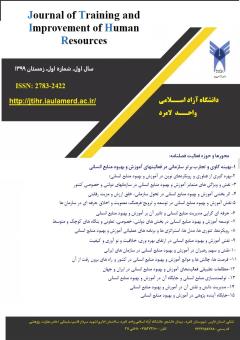Identifying and determining background variables in the design of cultural diversity management policies in Irans government organizations
Subject Areas : title1
alireza alinezhad jeydan
1
![]() ,
Mehdi Babay Ahari
2
*
,
Javad Mehrabi
3
,
Mehdi Babay Ahari
2
*
,
Javad Mehrabi
3
1 - Ph.D. candidate, Public Administration, Faculty of Management, Accounting and Human Sciences, Qazvin Islamic Azad University, Qazvin, Iran
2 - Faculty Member, Management Department, Adiban Higher Education Institute, Garmsar, Iran
3 - Department of Public Administration, Faculty of Management, Accounting and Human Sciences, Qazvin Islamic Azad University, Qazvin, Iran
Keywords: diversity management , cultural diversity, policy, government organizations , meta-analysis.,
Abstract :
In recent decades, diversity management has become a growing research field in management and organization studies. Despite the popularity of diversity management, the effects of these practices have not been studied except for the numerical representation of marginalized groups in management ranks. Therefore, the purpose of this research is to identify and determine the background variables in the design of cultural diversity management policies in Iran's government organizations. first, qualitative data were collected through library studies and evaluated based on meta-analysis. Background variables in the design of cultural diversity management policies in Iran's government organizations, 10 indicators were obtained, which were discussed in the managerial category and the social category. In the managerial category, development and cultural perceptions and in the social category, inter-structural cultural adaptation emerged as recurring themes throughout the research, indicating their significant impact. The findings show that the need for a more comprehensive approach to managing diversity in Iran's government organizations, identified indicators, such as development and cultural perceptions in the management category, and inter-structural cultural compatibility in the social category, highlight the multifaceted nature of cultural diversity management. slow This emphasizes the importance of considering managerial and social factors in the design and implementation of policies aimed at fostering cultural diversity in these organizations. Further research and practical applications in this area can lead to more effective and inclusive diversity management practices, which ultimately benefit organizations and the diverse individuals that comprise them.
1- Alfoqahaa, Sam, Jones, Eleri, (2020), Leading at the edge of chaos: historical perspectives on the qualities of leadership for cultural diversity and conflict resolution, International Journal of Public Leadership, Vol. 16 No. 2, 2020 pp. 217-248.
2- Alsulami, Sanaa Awwad, Sherwood, Gwen, (2020), The experience of culturally diverse faculty in academic environments: A multi-country scoping review, Nurse Education in Practice, 44, 102777.
3- Ansari, Mohammad Reza, Ghayomi, Abbas Ali, Salehi Amiri, Seyed Reza, Azizabadi Farahani, Fatemeh, Gadami, Mohsen, (2021), Presenting a cultural policy model with a transformation approach (case study of Tehran Islamic Azad University Research Sciences Branch), Scientific Quarterly Strategic Studies of Public Policy, Volume 11, Number 39.
4- Chau, Minh, (2020), Cultural Diversity and the Importance of Communication, Cultural Competence, and Uncertainty in Radiography, Journal of Medical Imaging and Radiation Sciences xx (2020) 1-6.
5- Darvishnejad, Amir Abbas (2022), investigating the relationship between managers' cultural diversity management skills and job enthusiasm and the mediating role of organizational indifference (case study: employees of the western municipalities of Mazandaran province), the second international conference on management, ethics and business, Shiraz. https://civilica.com/doc/1589209
6- Georgiadou, Andri, Alejandra, Maria, Miguel R. Gonzalez-Perez, Luján, Olivas, (2019), "Diversity within Diversity Management: Where We Are, Where We Should Go, and How We Are Getting There" In Diversity within Diversity Management. Published online: 26 Mar 2019; 1-20.
7- Gerald, Rossano V.(2024), The Practices of Diversity Management: How can diversity policies impact organizational performance?, Global Scientific and Academic Research Journal of Economics, Business and Management,3(2), p 59-66.
8- Grillitsch, Markus, Tavassoli, Sam, (2018), Cultural diversity and employment growth: Moderating effect of the recent global financial crisis, Australian Journal of Management, 1–21.
9- Hofhuis, J. (2022), "Comparing cultural diversity perspectives among public service employees in the Netherlands in 2008 and 2018", Equality, Diversity and Inclusion, Vol. 41 No. 5, pp. 726-738. https://doi.org/10.1108/EDI-01-2021-0002.
10- Hussain, Basharat, Sheikh, Abdullah, Timmons, Stephens, Stickley, Theodore, Repper, Jullie, (2020), Workforce diversity, diversity training and ethnic minorities: The case of the UK National Health Service, International Journal of Cross Cultural Management 1–21, DOI:10.1177/1470595820938412.
11- Iskanderpour, Behrouz, Abdul Alipour Adel, Yunus, Saeb Nia, Somia, (2022), Identifying and prioritizing the harms of cultural diversity in human resource management (Study: Mellat Bank branches in Ardabil city), the second national conference of future schools, Ardabil. https://civilica.com/doc/1404176
12- Kadam, R., Rao, S.A., Kareem Abdul, W. and Jabeen, S.S. (2020), "Diversity climate perceptions and its impact on multicultural team innovation and performance", Measuring Business Excellence, Vol. 24 No. 3, pp. 301-318. https://doi.org/10.1108/MBE-04-2019-0037.
13- Naghavi, N., Pahlevan Sharif, S. and Iqbal Hussain, H.B. (2021), "The role of national culture in the impact of board gender diversity on firm performance: evidence from a multi-country study", Equality, Diversity and Inclusion, Vol. 40 No. 5, pp. 631-650. https://doi.org/10.1108/EDI-04-2020-0092.
14- Obamiro, John Kolade, Kumolu-Johnson, Babatunde Oladipupo, Chidi Ngwamaj, Justice, (2019), Workforce Diversity and employee`s performance: Evidence from a Nigerian Bank, Journal of economic Behavior, Vol.9, 13-26.
15- Orsini, P., Magnier-Watanabe, R. (2023), "Foreign coworker nationality, cultural distance, and perception of cultural diversity in the workplace", Journal of Asia Business Studies, Vol. 17 No. 2, pp. 256-278. https://doi.org/10.1108/JABS-10-2021-0413.
16- Roberson QM (2019) Diversity in the workplace: a review, synthesis, and future research agenda. Annual Review of Organizational Psychology and Organizational Behavior 6: 69–88.
17- Shahid Khan, Poramet Saengon, Muhammad, Charoenpoom, Suppara, Soonthornpipit, Hathaipan, Chongcharoen, Duangkamol, (2020), The impact of organizational learning culture, workforce diversity and knowledge management on innovation and organization performance: A structural equation modeling approach, Human Systems Management, DOI 10.3233/HSM-200984.
18- Wei, Shuqi (2024), Discussion of Cross-Culture Management in Cultural Diversified Workplace, Journal of Sociology and Ethnology, 6(1), 164-168. DOI:10.23977/jsoce.2024.060122
19- Yasmeen, Aiza, Ahmad, Mansoor, Raziq, Muhammad Mustafa, Laeeq Khan, Muhammad, (2020), Structural empowerment, cultural diversity, and interpersonal conflict: Evidence from international NGOs in Pakistan, International Journal of Cross Cultural Management 1–15, DOI: 10.1177/1470595820904391.

